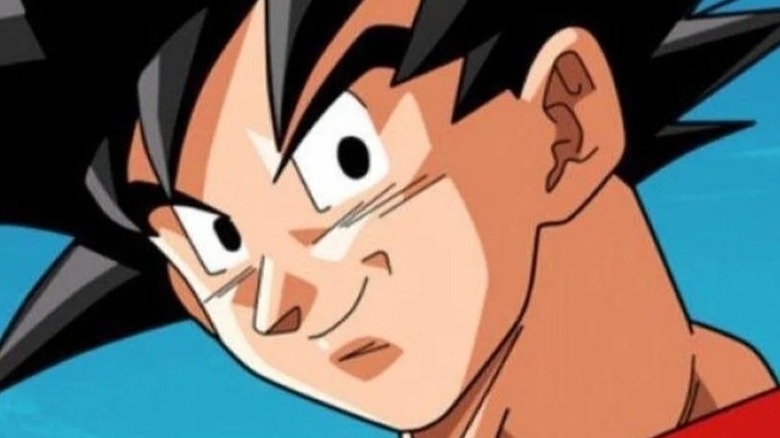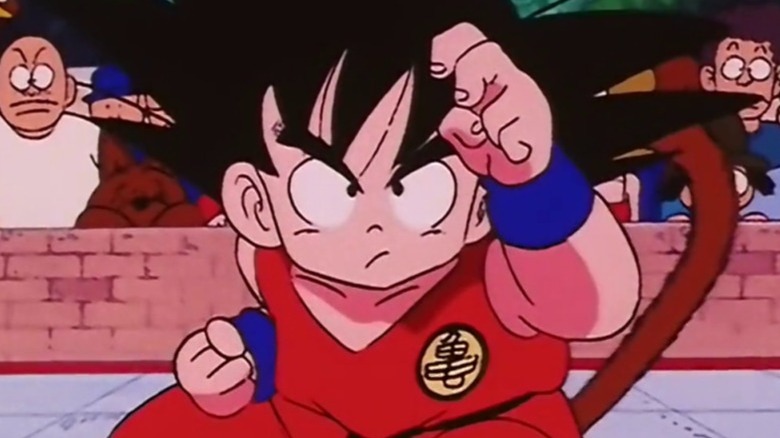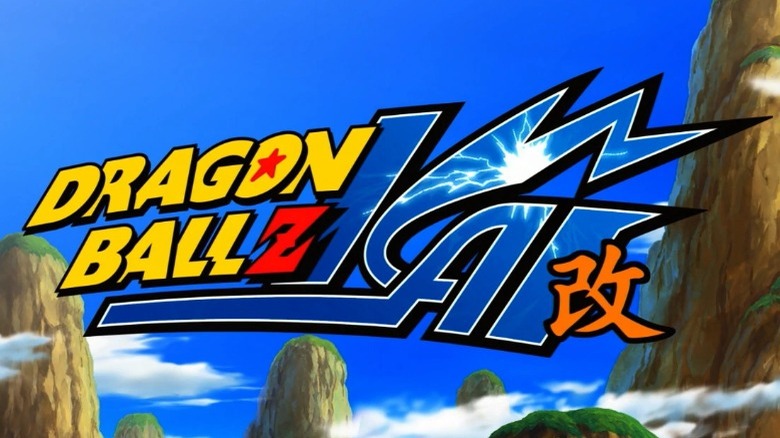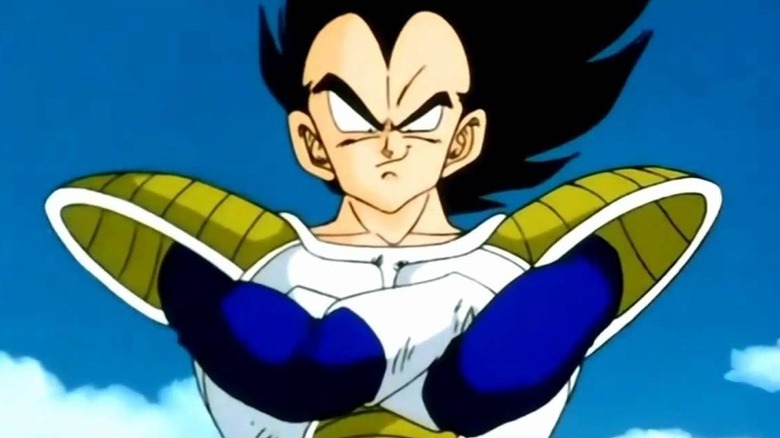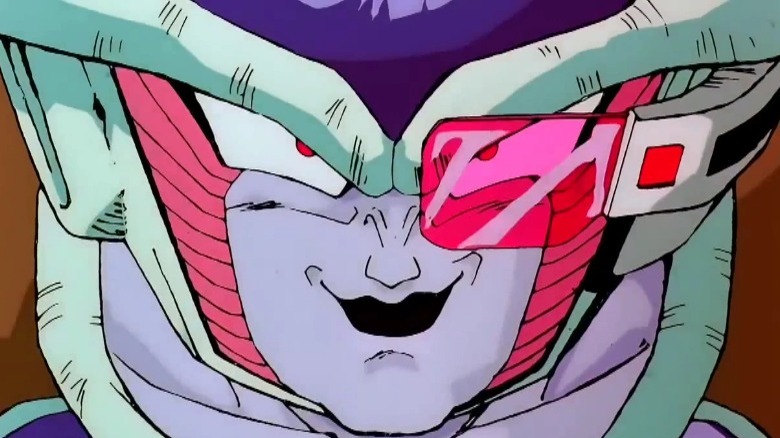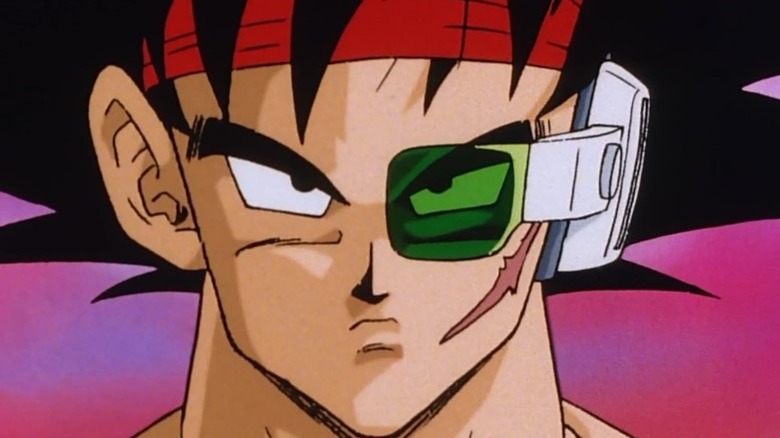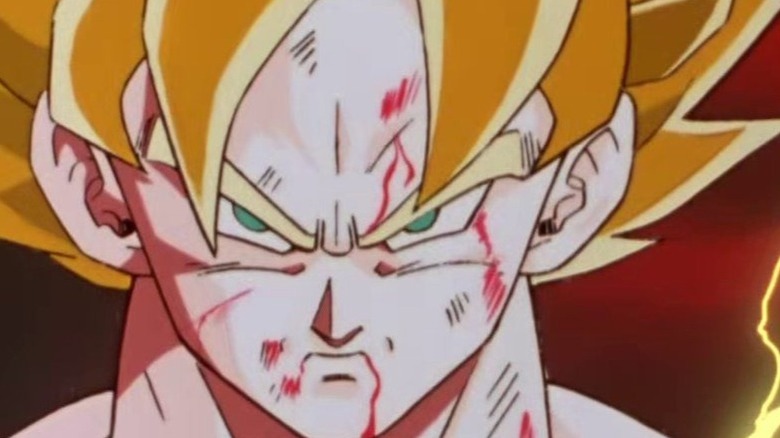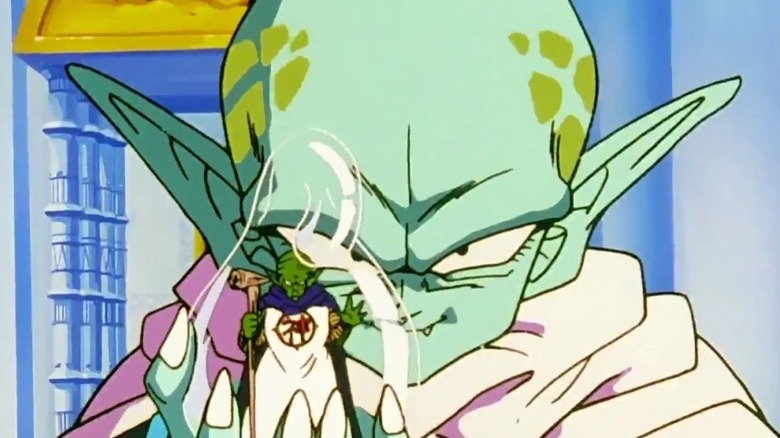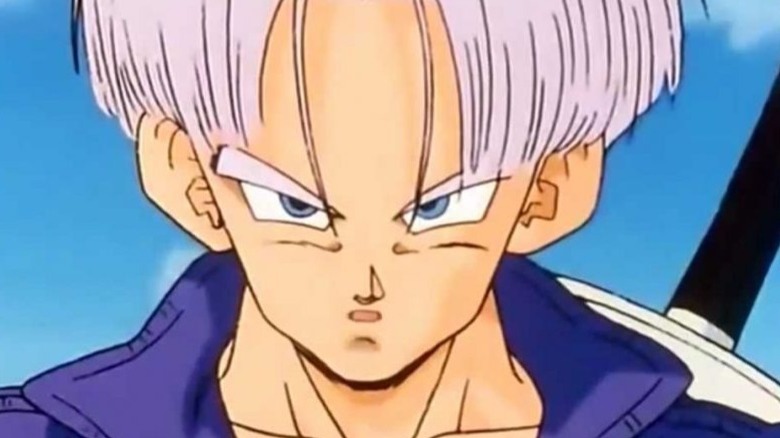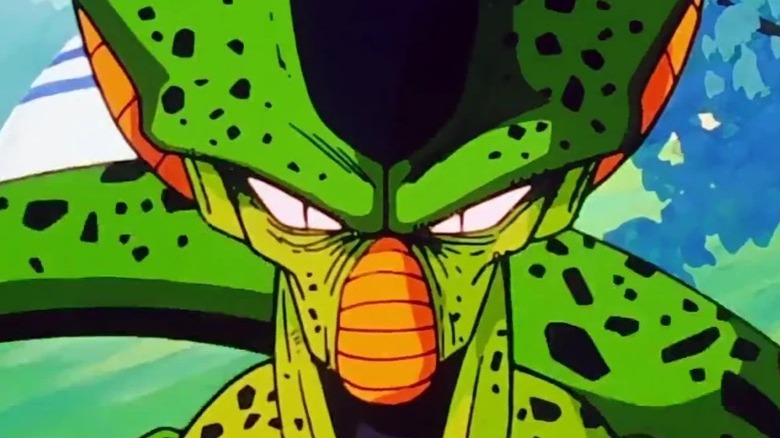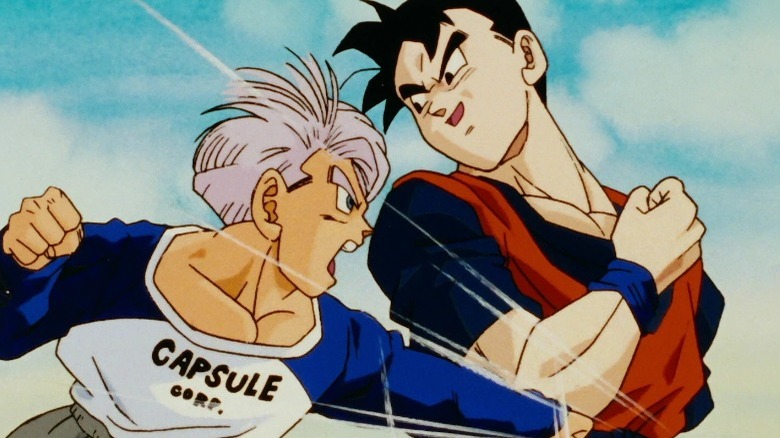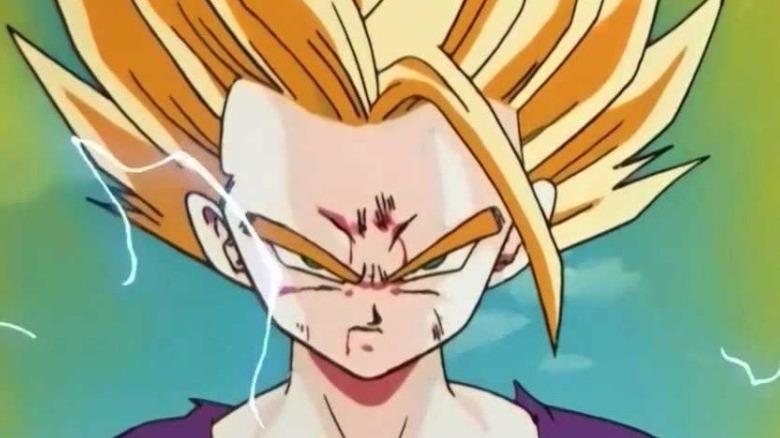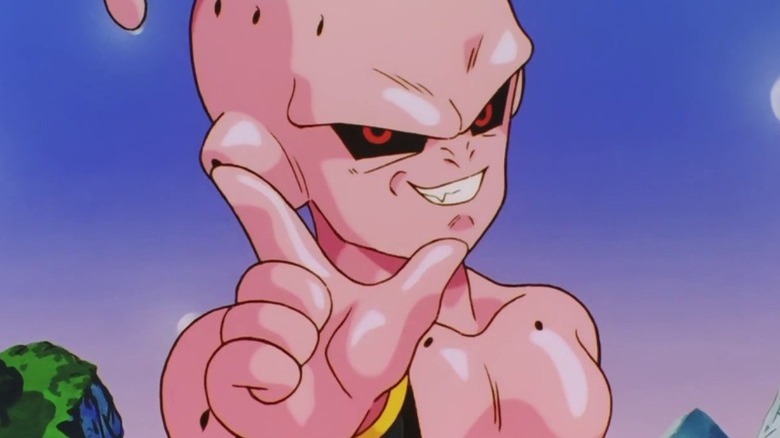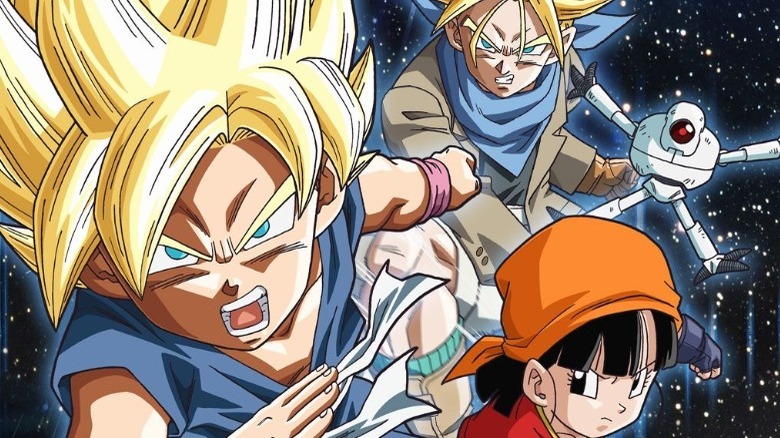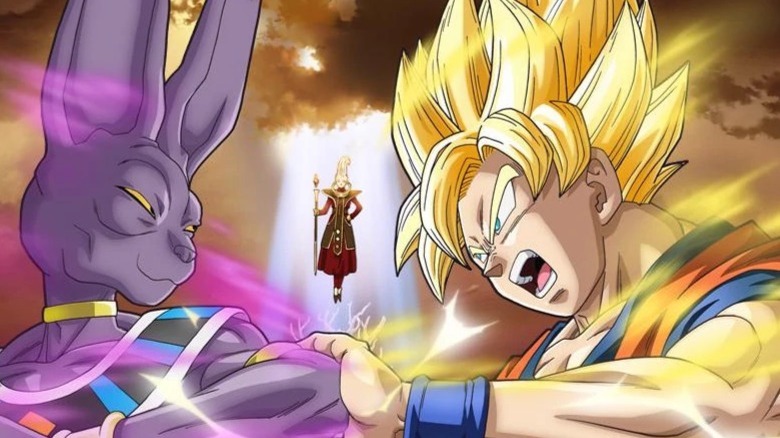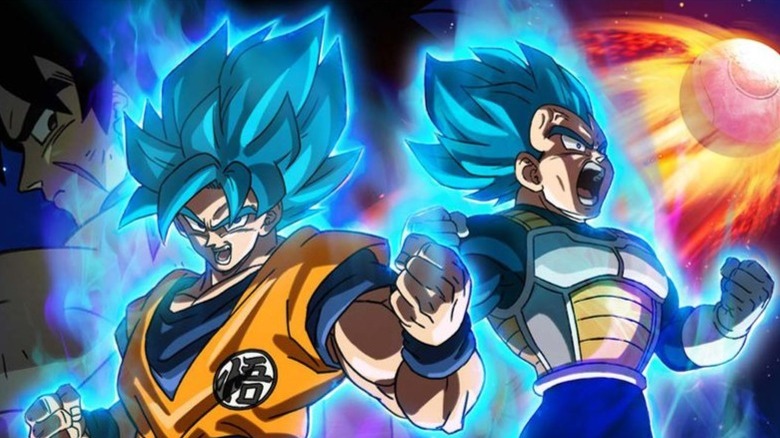The Right Way To Watch The Dragon Ball Series In Order
Although your average American may or may not have a hard time telling you much about it, Dragon Ball is one of the most successful franchises in the world. It began in the mid-'80s as a manga written and drawn by series creator Akira Toriyama, and has since been adapted into multiple anime series that have expanded the universe – along with its fan base.
With so much Dragon Ball to watch and more on the way (including a new movie, "Dragon Ball Super: Super Hero"), it's natural for newcomers to wonder how they should go about watching the franchise. Do they start with the most popular show, "Dragon Ball Z," and then watch the others? Should they begin with the first series, "Dragon Ball"? Or should they try watching everything chronologically and kick things off with the first few minutes of "Dragon Ball Super: Broly"? Also, how do "Dragon Ball GT" and the movies factor in — that is, if they do at all?
As it turns out, the most satisfying way to watch the long-running action series is by release date ... with a few exceptions, here and there. Read on for a gameplan — and if you're about to dive into the Dragon Ball franchise for the first time, consider us envious.
Purists start with Dragon Ball
Many people begin with "Dragon Ball Z," as it's the most popular Dragon Ball anime series and can be understood fairly well even without watching its predecessor. Still, those interested in seeing how the franchise evolved should start with the 1986-1989 series "Dragon Ball."
It may be slower-paced than "Z" and the action scenes aren't quite as flashy, but the show still provides an invaluable look at Goku's early years. Fans also get to see supporting characters like Korin, Master Roshi and Kami feature more prominently, as well as learn the surprising roles longtime allies like Tien, Yamcha and Chiaotzu had when first introduced. Beginning with "Dragon Ball" might also give fans a different impression of certain characters than they'd get from watching "Z" first, particularly Yamcha and Yajirobe, who are shown to be more formidable than later series sometimes suggest. Moreover, several elements from "Dragon Ball" are revisited or followed up on in later series.
Once viewers finish the series, they can also watch the "Dragon Ball" feature movies "Curse of the Blood Rubies," "Sleeping Princess in Devil's Castle" and "Mystical Adventure." They aren't canon or essential viewing, but are charming films that make several interesting changes to the source material.
Dragon Ball Z or Dragon Ball Z Kai?
For years, Dragon Ball viewing was quite straightforward. There were only two shows and "Dragon Ball Z" was clearly the sequel to "Dragon Ball."
Yet today, two versions of the "Dragon Ball Z" anime exist. First there's 1988's "Dragon Ball Z," which adapted the latter half of the "Dragon Ball" manga, but added several scenes to fit the average length of an anime episode. Then there's 2009's "Dragon Ball Kai" — named "Dragon Ball Z Kai" in the U.S. — and its sequel "Dragon Ball (Z) Kai: The Final Chapters," which took the animation from the original "Z" and removed much of the anime-only (a.k.a. "filler") material, while both re-dubbing and re-coloring the remaining footage. The two Kai shows are much shorter — and the closest fans can get to watching the manga in anime form — but "Z" has far more content, and certain anime-only scenes are quite beloved.
If you're in a hurry or want something as close to the manga as you can get, watch the "Kai" shows. If you want to take your time with the series, however, go with "Z." But in a perfect world, watch all three! Whichever choice you make, you'll be able to go from "Z" and/or "Kai" to the next canon show, "Dragon Ball Super," seamlessly. Just know that the anime-only scenes in "Z" and "Kai" are often excluded from fan debates.
Continue with the Saiyan Saga
No matter what version of "Dragon Ball Z" you pick, you'll still kick things off with the Saiyan Saga, which reveals that Goku comes from a race of alien conquerors known as the Saiyans, while his arch-foe Piccolo is a member of the pacifist Namekian species. The revelations play a huge role in the series going forward, as do many other elements of the Saiyan Saga, including Piccolo re-forming and bonding with Goku's son Gohan, who appears for the first time. Other major character debuts include the Saiyan Prince Vegeta, whose slow path to redemption lasts all of "Z," and Other World fighting instructor King Kai.
Once new fans finish the Saiyan Saga, they should watch the first three "Dragon Ball" Z movies. The "Z" films may not be canon, but are undeniably entertaining and a vital part of fan discourse. Movies 2 and 3, "The World's Strongest" and "The Tree of Might," are clearly set after the Saiyan Saga (ignoring continuity issues), and while Movie 1 ("Dead Zone") is set before "DBZ" begins, it should be watched after the Saiyan Saga to avoid spoiling one of "Z's" earliest surprises regarding Gohan.
Watch every Frieza Saga episode, but stop right before Goku fights Frieza
Frieza's first major story is one of the most important sagas in Dragon Ball, given how vital Frieza has become to the franchise in general. Furthermore, the story arc introduced Piccolo's home world, Namek (complete with a brand new wish-granting dragon, Porunga) and features the first canonical appearance of the original Super Saiyan transformation, opening the door for the various Super Saiyan stages that followed. The Frieza Saga also sets a precedent for villain transformations, with Frieza being the first major antagonist who could transform multiple times. Even Fusion technically debuts in the Frieza Saga, starting with Piccolo using Namekian Fusion on Nail.
That said, don't just charge through the entire saga right away. Go all the way up to the introduction of the Ginyu Force, or stop right before Goku arrives to fight Frieza himself, as there's some crucial backstory you might want to watch beforehand.
It may not be canon anymore, but you can't skip Bardock: The Father of Goku
Namely, this is the TV special that introduced Goku's father. Bardock debuted in the "Dragon Ball Z" anime before he appeared in the "Dragon Ball" manga; a rarity, as back then, the franchise usually introduced characters the other way around. Though rendered non-canon by later stories, "Bardock: The Father of Goku" is still required viewing, namely because of its quality and compelling, morally-complex protagonist. The special also introduced the one scene that became canon across all Dragon Ball continuities, namely Bardock's final showdown with Frieza, which an impressed Toriyama kept largely intact when adapting it to the manga. Bardock's crew even made a quick cameo in "Dragon Ball Super: Broly."
"Bardock: The Father of Goku" is best viewed right before the first episode of Goku's battle with Frieza, which features flashbacks from the special. Alternately, it can be viewed immediately after the Ginyu Force's defeat, thus keeping Frieza's transformations (which don't appear in the special) a surprise. Its sequel, "Episode of Bardock," makes Bardock a Super Saiyan, but is perhaps best skipped, as some feel it takes away from the original's story power.
Watch Goku's showdown with Frieza, then Movie 4
Goku's titanic showdown with Frieza set a new precedent for "Dragon Ball" battles. After all, not every bout in anime ends with the destruction of a planet. These are the episodes where Goku's Super Saiyan transformation finally appears, along with some of Frieza's most infamous attacks. Perhaps the biggest legacy of these episodes, however, is Goku and Frieza's long-standing feud, which begins here and is later revisited in "Dragon Ball Z: Resurrection 'F'" and "Dragon Ball Super."
Once fans complete the Frieza Saga, they can check out "Dragon Ball Z" Movie 4, "Lord Slug." The film's continuity issues are bizarre even by "DBZ" movie standards, as "Lord Slug" actually introduces a notably-different version of the Super Saiyan transformation. Though seemingly set before Goku's fight with Frieza, "Lord Slug" is better seen afterward, if only so viewers don't think its "Pseudo Super Saiyan" form is more legitimate than the real one from the show.
The Garlic Jr. Saga isn't a must-watch, but it does set up a minor subplot in later episodes
The saga that brought back "Dead Zone" villain Garlic Jr. is the only arc in the Dragon Ball shows where Goku is completely absent, and is the only one to feature a villain that originated in the "DBZ" movies. It also does not exist in the manga, and was omitted from "Dragon Ball Z Kai."
For those last two reasons alone, some argue that the Garlic Jr. Saga can be safely skipped. Still, the polarizing arc has several redeeming qualities. Chief among them is that Goku's absence gives other characters like Gohan, Piccolo and Goku's best friend Krillin the chance to save the day. The story also gives Kami, the Guardian of Earth (referred to as Earth's god in the manga and original Japanese audio) significant time in the spotlight, following up on his rivalry with Garlic Jr. from "Dead Zone."
Fans of Gohan's pet dragon from the "DBZ" movies, Icarus, will also be pleased, as the Garlic Jr. Saga is the only arc in the series where he appears. Skipping the arc might also cause some minor confusion down the road, as Maron, Krillin's girlfriend in the story, reappears briefly in later "DBZ" episodes.
Watch Future Trunks' fight with Frieza, then Movie 5
Future Trunks' arrival to the series is a game changer. Aside from being the first major sword user the franchise had seen in a while and its second Super Saiyan, the warrior from the future quickly ups the stakes by defeating Frieza and his father, King Cold, with next to no effort. He also introduces time travel into the world of Dragon Ball, along with one of its most shocking pairings, Vegeta and genius human scientist Bulma ... who Trunks reveals are his parents.
Naturally, Trunks also sets up the next "DBZ" threats, the Androids — further making these episodes required viewing. As Trunks' debut also marks Frieza's last major appearance on the show (though he briefly appears in several anime-only scenes later) "Cooler's Revenge" (aka Movie 5) can be watched fairly seamlessly afterward, as the film features Frieza's brother Cooler coming to Earth to avenge his brother. For best viewing, watch Movie 5 right before the Androids' arrival.
Watch the Cell Saga all the way up to Dende becoming Earth's new Guardian ... and sprinkle in some movies, while you're at it
Proof that "DBZ" is never one to sit on its laurels, the Cell Saga reveals that the all-powerful Super Saiyan form can be improved upon and even surpassed, as first seen with "Super Vegeta" and "Super Trunks." Moreover, it brings in Android 17 and 18, who become the arc's main antagonists before being supplanted by Cell and reforming. The Cell Saga is also where Vegeta's rivalry with Goku, hinted at in the Garlic Jr. Saga, begins in earnest, while a fan-favorite hero's redemption arc comes full circle when Piccolo fuses with Kami.
Most of the Cell Saga can be watched continuously. Once Dende is made Kami's replacement, however, it's movie time, as the sixth film, "The Return of Cooler," already features him as Earth's new Guardian. From there, you can watch "Super Android 13" immediately afterward, followed by "Broly – The Legendary Super Saiyan," which introduces the most popular "DBZ" movie villain.
Can't forget the History Of Trunks
The "Dragon Ball: The History of Trunks" TV special shows the future warrior's early days training with Future Gohan and fighting Androids 17 and 18. While the special does recap some of what Trunks had already revealed on the show, such as the death of "Z's" main cast of fighters, it also offers new information, such as who else among the supporting cast survived besides Trunks' mother, Bulma. Additionally, it reveals the heartbreaking incident that caused Trunks to become a Super Saiyan: a major change from the manga version of the same story, where Trunks had already learned the Super Saiyan technique before said tragedy occurred.
For the best viewing experience, watch the special either right before the Cell Games (which is roughly when it was originally released in Japan) or during Super Trunks' battle with Perfect Cell, which features flashback scenes from Trunks' past; it's also when the original manga version of the story ("Trunks The History — The Lone Warrior") came out.
Finish the Cell Saga, then watch Movie 9
After the Trunks special, all that's left of the Cell Saga are the Cell Games and the episode where Trunks returns to his timeline. The important character of the Cell Games, however, is Gohan, who officially surpasses Goku as a fighter and becomes his father's successor (for a little while, anyway). The Cell Saga's conclusion also marks the last saga in "Z" that Earth's fighters play major roles in, though they'd become more involved in fights again in the Toriyama-scripted "Dragon Ball Z" movies. They do appear in the next "Z" arc, the Buu Saga, but less prominently.
Movie 9, "Bojack Unbound," serves as a fitting postscript for the Cell Saga, as it features Gohan cementing his newfound status as Earth's main hero by defeating Bojack and his pirates ... albeit with a little help. For many years, "Bojack Unbound" was the one movie of the first 13 "DBZ" films that could have most easily fit into canon, although that may have changed, thanks to the Future Trunks Saga in "Dragon Ball Super."
Finish Z Right with the Buu Saga (And Movie 13)
The "Z" era of the Dragon Ball franchise ends with a bang, thanks to the arrival of Majin Buu, the show's most powerful threat. The Buu Saga is filled with major milestones, including Goku's return, the introduction of new characters and fusions, and Gohan getting his Ultimate (a.k.a. "Mystic") power-up. The saga's biggest moments, however, involve Vegeta, who briefly reverts to villainy before finally completing his redemption arc. Even Mr. Satan, the Cell Saga's martial arts con man, "redeems" himself by helping the real heroes save Earth.
It's worth watching the Buu Saga pretty much the whole way through, including the anime-only Other World tournament from the original "DBZ" anime, which is followed up on in several filler scenes and Movie 12, "Fusion Reborn." As far as films go, watch Movie 10, "Broly: Second Coming," before the Buu Saga's World Martial Arts Tournament, then watch Movie 11, "Bio-Broly," after Goku returns to Other World. "Fusion Reborn" can be watched shortly after Gotenks (the fusion of Goku's new son. Goten and a modern-day Trunks) becomes a Super Saiyan on the show, and Movie 13, "Wrath of the Dragon," fits right before the Buu Saga's 10-year jump.
You don't HAVE to watch Dragon Ball GT ... but if you do, watch it after Movie 13
Sure, "Dragon Ball GT" is set further in the future than "Dragon Ball Super," but it was created many years before "Super" existed, specifically as a sequel to "Z." Therefore, it's best to stick with release order and watch it right after "Wrath of the Dragon," especially as Goku's Dragon Fist technique from that film appears in "GT" often.
Still, "GT" isn't required viewing, especially since "Super" has confirmed the show is neither canon to the anime or the manga. Like the Garlic Jr. Saga for "Z," "GT" is a fairly divisive entry in the Dragon Ball franchise, but it's not without its charm.
It's the only series that features Goku's granddaughter Pan as a main character, and gives Goku and Vegeta a brand new transformation, "Super Saiyan 4," whose only other anime appearance has been in the (very non-canon) "Super Dragon Ball Heroes" promotional web series. Moreover, the show's emotional moments are consistently well-done, and the Shadow Dragon Saga provides a strong "what if?" ending to Goku's adventures, while making an interesting argument against using the Dragon Balls too often. Should you check out "GT," watch the movie "Dragon Ball GT: A Hero's Legacy" afterwards to learn more about Pan's successor from the show's finale, Goku Jr.
Watch Dragon Ball Z Movies 13 and 14, or just charge right into Super
"Dragon Ball Z: Battle of Gods" and "Dragon Ball Z: Resurrection 'F'" (aka, movies 14 and 15) hailed a resurgence of the franchise, and were the first two movies scripted by Dragon Ball's creator, Akira Toriyama. Set after Kid Buu's defeat, but before "DBZ's" final episodes, the films introduced Beerus and Whis, who would push Goku and Vegeta to new levels of strength and kick off the series "Dragon Ball Super."
Given their minor continuity contradictions, Movies 14 and 15 aren't considered canon. However, both were adapted in the "Dragon Ball Super" TV series, which can be considered the official continuation of the Dragon Ball saga ... unless one considers the "Dragon Ball Super" manga to be that continuation, that is.
Either way, Akira Toriyama was much more involved in creating both than he was in "GT." Fans can choose to skip the movies, as they're both retold in "Super," although they're still worth a watch. If you really want to be a completist, see if you can legally find the special "Yo! Son Goku And His Friends Return!!" before watching Movie 14, if only to learn about the mysterious "Tarble" everyone in Toriyama's movies keep talking about.
Dragon Ball Super: Broly is the first canonical Dragon Ball film ... and reinvents the most popular Z movie villain
Luckily for Dragon Ball fans, Akira Toriyama has continued scripting movies for the franchise, including the first one to be considered in-continuity: "Dragon Ball Super: Broly."
Ironically, it stars a villain who was previously not canon, making several changes to Broly that ultimately make him more sympathetic than the cruel killing machine from the "Z" films. Toriyama also adapted the manga story that knocked "Bardock: The Father of Goku" out of continuity, "Dragon Ball Minus," and its more sympathetic version of Bardock into the film.
While Toriyama's changes to Bardock were not as universally well-received as his reinvention of Broly, the movie is still pretty highly regarded, and a must-watch for fans wanting the full "Dragon Ball" story.
